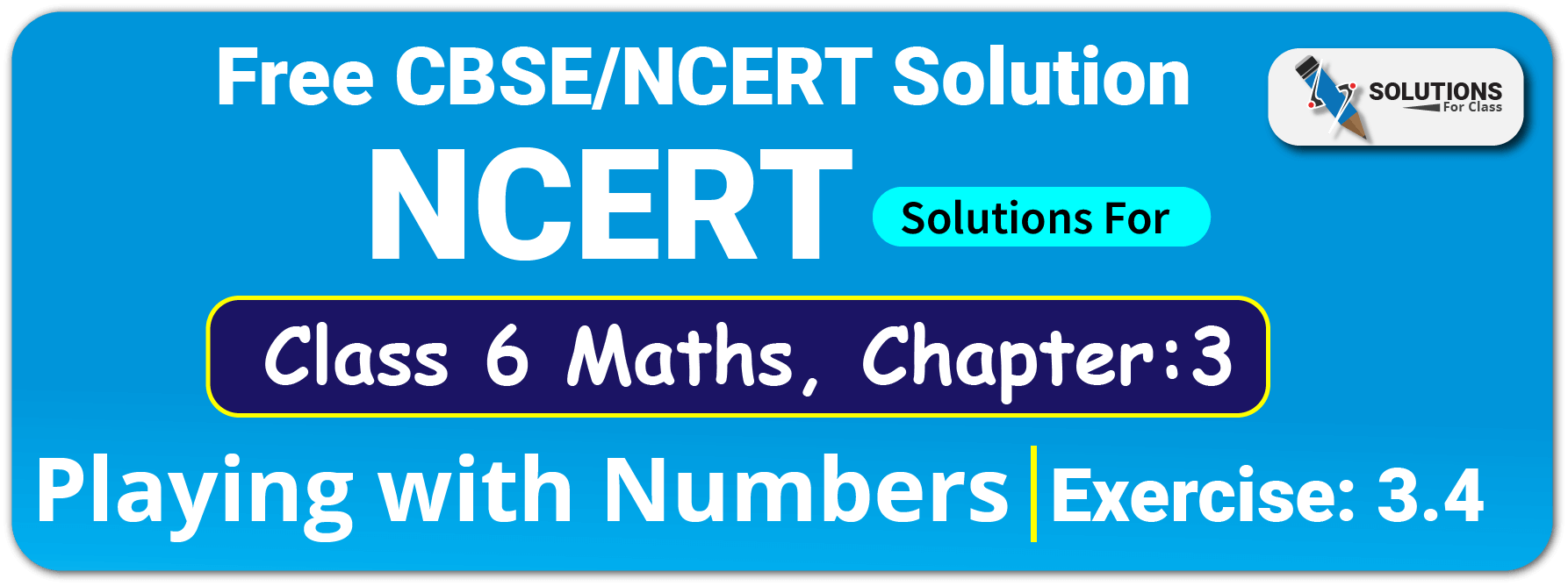
Table of Contents
ToggleClass 6, Maths, Chapter 3, Exercise 3.4 Solutions
Q.1. Find the common factors of :
(a) 20 and 28
(b) 15 and 25
(c) 35 and 50
(d) 56 and 120
Ans:
(a) 20 and 28
To find the common factors of 20 and 28, we can list the factors of each number and find the ones they have in common.
The factors of 20 are: 1, 2, 4, 5, 10, 20.
The factors of 28 are: 1, 2, 4, 7, 14, 28.
The common factors of 20 and 28 are the ones they both have in common, which are: 1, 2, and 4.
Therefore, the common factors of 20 and 28 are 1, 2, and 4.
In other words:
Factors of 20 = 1, 2, 4, 5, 10, 20
Factors of 28 = 1, 2, 4, 7, 14, 28
Common factors = 1, 2, 4
(b) 15 and 25
Factors of 15 = 1, 3, 5, 15
Factors of 25 = 1, 5, 25
Common factors = 1, 5
(c) 35 and 50
Factors of 35 = 1, 5, 7, 35
Factors of 50 = 1, 2, 5, 10, 25, 50
Common factors = 1, 5
(d) 56 and 120
Factors of 56 = 1, 2, 4, 7, 8, 14, 28, 56
Factors of 120 = 1, 2, 3, 4, 5, 6, 8, 10, 12, 15, 20, 24, 30, 60, 120
Common factors = 1, 2, 4, 8
Q.2. Find the common factors of :
(a) 4, 8 and 12
(b) 5, 15 and 25
Ans:
(a) 4, 8 and 12
Factors of 4 = 1, 2, 4
Factors of 8 = 1, 2, 4, 8
Factors of 12 = 1, 2, 3, 4, 6, 12
Common factors of 4, 8 and 12 = 1, 2, 4
(b) 5, 15 and 25
Factors of 5 = 1, 5,
Factors of 15 = 1, 3, 5, 15
Factors of 25 = 1, 5, 25
Common factors of 5, 15 and 25 = 1, 5
Q.3. Find first three common multiples of :
(a) 6 and 8
(b) 12 and 18
Ans:
(a) 6 and 8
Multiple of 6 = 6, 12, 18, 24, 30, 36, 42, 48,54, 60,72, ………..
Multiple of 8 = 8, 16, 24, 32, 40, 48, 56, 64, 72, ………….
Common multiples of 6 and 8 = 24, 48, 72
(b) 12 and 18
Multiple of 12 = 12, 24, 36, 48, 60, 72, 84, 96, 108, 120, ………….
Multiple of 18 = 18, 36, 54, 72, 90, 108, 126………
Common multiples of 12 and 18 = 36, 72, 108
Q.5. Which of the following numbers are co-prime?
(a) 18 and 35
(b) 15 and 37
(c) 30 and 415
(d) 17 and 68
(e) 216 and 215
(f) 81 and 16
Ans:
Co -prime: Two numbers are said to be co-prime if they don’t have any common factor other than 1
(a) 18 and 35
Factors of 18 = 1, 2, 3, 6, 9, 18
Factors of 35 = 1, 5, 7, 35
Common factor = 1
Since, their common factor is 1. Hence, they are co-prime numbers.
(b) 15 and 37
Factors of 15 = 1, 3, 5, 15
Factors of 37 = 1, 37
Common factors = 1
Since, their common factor is 1. Hence, they are co-prime numbers.
(c) 30 and 415
Factors of 30 = 1, 2, 3, 5, 6, 10, 15, 30
Factors of 415 = 1, 5, 83, 415
Common factors = 1, 5
Since, both have more than one common factor. Hence, they are not co-prime numbers.
(d) 17 and 68
Factors of 17 = 1, 17
Factors of 68 = 1, 2, 4, 17, 34, 68
Common factors = 1, 17
Since, both have more than one common factor. Hence, they are not co-prime numbers.
(e) 216 and 215
Factors of 216 = 1, 2, 3, 4, 6, 8, 9, 12, 18, 24, 27, 36, 54, 72, 108, 216
Factors of 215 = 1, 5, 43, 215
Common factors = 1
Since, their common factor is 1. Hence, they are co-prime numbers.
(f) 81 and 16
Factors of 81 = 1, 3, 9, 27, 81
Factors of 16 = 1, 2, 4, 8, 16
Common factors = 1
Since, their common factor is 1. Hence, they are co-prime numbers.
Q.6. A number is divisible by both 5 and 12. By which other number will that number be always divisible?
Ans:
Multiple of 5 = 5,10,15,20,25,30,35,40,45,50,55,60….
Multiple of 12 = 12,24,36,48,60….
Answer: Common factor is 60.
Q.7. A number is divisible by 12. By what other numbers will that number be divisible?
Ans:
Factors of 12 = 1, 2, 3, 4, 6 and 12
Since, the number is divisible by 12. Hence, it also divisible by its factors i.e. 1, 2, 3, 4, 6
NCERT Solutions For Class 6 Maths, Chapter 3 Playing With Numbers (All Exercises)
Class 6, Maths, Chapter 3, Playing With Numbers
Class 6, Maths, Chapter 3, Playing With Numbers, Exercise 3.1
Class 6, Maths, Chapter 3, Playing With Numbers, Exercise 3.2
Class 6, Maths, Chapter 3, Playing With Numbers, Exercise 3.3
Class 6, Maths, Chapter 3, Playing With Numbers, Exercise 3.4 ← You are here
Class 6, Maths, Chapter 3, Playing With Numbers, Exercise 3.5
Class 6, Maths, Chapter 3, Playing With Numbers, Exercise 3.6
Class 6, Maths, Chapter 3, Playing With Numbers, Exercise 3.7

